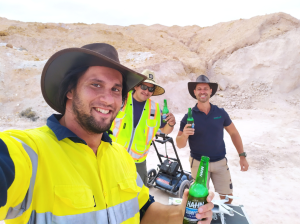“Becoming a Certified Locator is about applying the knowledge, skills and processes in the field. Having a national standard and framework helps safeguard professionals, as well as the clients and assets we work to protect. For me, safety is a number one priority.”
“I see our job as contributing to that by applying our skills and knowledge and using the right equipment to locate and identify underground assets to protect them from damage, and, in turn, protect the people who will then work on the site – and the public too,” explained Joshua.
Joshua experienced a situation which highlighted the importance of applying a careful and diligent process, as well as making sure when a client hires a utility locator they check the locator is at least competent and at best a Certified Locator.

“We did a job at a school once where a construction project was underway. Despite previous attempts to locate the services on site, the school’s power and water were both cut during the works. So we were brought in to have a good look around and find what services were buried where.”
“Since they already experienced issues with the previous damage, we wanted to be extra thorough. In addition to the assets we had already EMF located, we brought in the GPR to get a greater insight of what else might be hiding underground and provide that peace of mind,” said Joshua.
As with many locators, one of the aspects Joshua loves about utility locating is that every job is different, and he gets to learn and experience something new every day.
 “I enjoy being able to use many different pieces of equipment, including push GPR and concrete scanners. One of the most interesting jobs involved heading to the Outback to scan for improperly filled, abandoned mine shafts,” said Joshua.
“I enjoy being able to use many different pieces of equipment, including push GPR and concrete scanners. One of the most interesting jobs involved heading to the Outback to scan for improperly filled, abandoned mine shafts,” said Joshua.
Joshua says one of the great things about locating is that when there’s skills or concepts you’re not understanding or applying properly, it’s easy to access the support to learn and brush up on your skills and knowledge.
“In the process of becoming a Certified Locator, I found I struggled a bit with locating sondes. Kim Simpson, one of the DBYD Certification assessors, gave me some useful feedback which helped immensely in that regard,” shared Joshua.
If you’re thinking about making the move to utility locating and then getting certified, Joshua recommends doing a locating training course and finding good people in the industry to help you learn.
“This is important for becoming a good locator, as well as for learning to run a business if you’re going to work alone. Getting to know your peers in the industry can also help in finding the right equipment for a reasonable price, and obtaining work,” said Joshua.
“If you’re in doubt about locating, even after running through different methods in your skillset, pack it up. Locating isn’t a guessing game. Clients need to know your receiver isn’t a magic wand.”
“It’s okay for someone with more experience, or additional equipment such as a hydrovac truck, to get involved and complete a job safely,” added Joshua.
If you’re interested in connecting with Joshua or Subsurface Locating, feel free to reach out:
Connect with Subsurface Locating on Instagram and visit their website.
Find out more about becoming a Certified Locator here.
To contact a Certified Locator for your next project search here.
In addition to operating Subsurface Locating, Joshua also moonlights with South East Scanning.